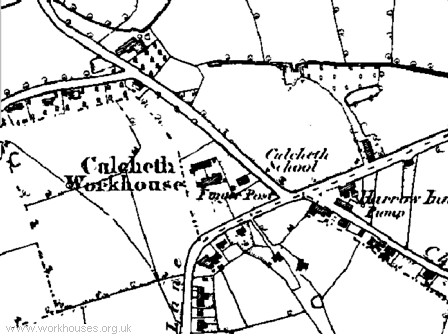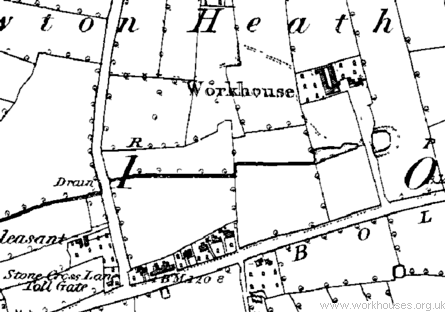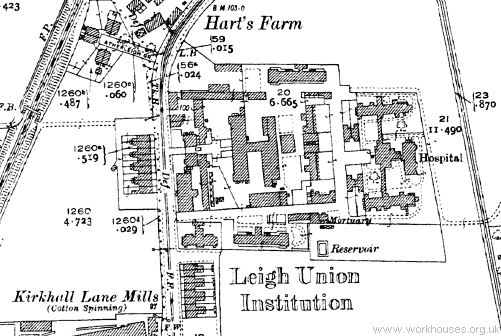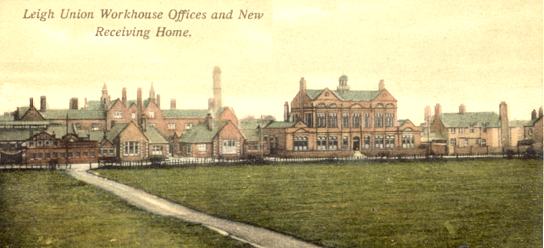Leigh, Lancashire
Up to 1834
Culcheth had a workhouse from 1731, as did Atherton from the following year, with Pennington opening one in 1739 (Hitchcock, 1985).
A building on King Street in Leigh served as a workhouse from 1750 to 1823.
In a parliamentary report of 1776, Culcheth — later to form part of the Leigh Poor Law Union — was listed as having a workhouse with accommodation for 50 inmates. Early workhouses also operated at Tyldesley and Lowton.
The Culcheth workhouse was located near the junction of what are now Common Lane and Jackson Avenue.

Culcheth workhouse site, 1849.
Lowton's workhouse was at Newton Heath, in the triangle now formed Newton Road, Heath Lane, and Stone Cross Lane South.

Lowton workhouse site, 1849.
After 1834
The Leigh Poor Law Union was formed on 15th February 1837. Its operation was overseen by an elected Board of Guardians, 18 in number, representing its 8 constituent parishes as listed below (figures in brackets indicate numbers of Guardians if more than one):
County of Lancaster:
Astley (2), Atherton (2), Bedford (2), Culcheth (2), Lowton (2), Pennington (2), Tyldesley cum Shakerley (3), West Leigh (2).
Later Additions: Golborne (from 1850), Newchurch Kenyon (from 1845).
The population falling within the Union at the 1831 census had been 24,960 with parishes ranging in size from Astley (population 1,832) to Tyldesley cum Shakerley (5,038).
In its early years, the Leigh Union continued to use existing local workhouses at Culcheth and Lowton. A new union workhouse was eventually erected in Leigh on a site at the east side of Leigh Road in 1850-1 at a cost of £8,000. It was later described as a "fine gothic building" and accommodating 400 inmates.
In September 1866, the workhouse was visited by Poor Law Board Inspector Mr R.B. Cane. His report noted:
There are vagrant wards, which are generally sufficient, but they are defective in the means for convenience and decency. These defects are to be remedied, I am told. Work is exacted. Oakum picking is the chief task. Sometimes the men are set to work pumping water, a very objectionable arrangement, as they are thus brought into communication with the other inmates of the workhouse.
There no boundary wall or fence to the workhouse premises, and on three sides intercourse with the inmates may be quite easily carried on. Any improper articles may be conveyed to the infirmary, which is exposed to the garden and the fields. The yards are in a bad state. In some there are holes in which the water stands; others are grown over with weeds. The want of pavement of some kind renders it more difficult to keep the lower part of the house in a cleanly state. The yard of the female lunatics' ward is partly given up to the nurses' poultry, and is otherwise in an improper condition.
There are no dining tables in the infirm men's halls. There is no place on which the inmates can place their plates when eating, and they, therefore, dine of their knees. No knives or forks are provided; the want of them must be most inconveniently felt, especially when meat is provided for dinner.
There are many "double beds" for men, and at times many of the men sleep together two in a bed; a most objectionable and indecent custom.
There is a detached fever ward. At present it is not in a thoroughly cleanly and satisfactory state. The water-closets an not supplied with water. The privy in the girls' ward is attached to the outside of one of the wards. It is highly offensive occasionally to the inmates of the fever wards. There are two fever cases in the ward at the present time. They have only a pauper attendant at night, and they are then locked in together, and cannot communicate with the nurse, however urgent the necessity may be. There is no distinct itch ward. Itch cases are sometimes treated in the fever wards.
In the infirmary there is no classification of cases. Sick cases, idiots, insane, and cases of infirmity from old age are associated together. The sexes merely are divided, and women and girls, and boys and men, occupy the same wards with each other. There is an insufficient supply of water to the water-closets. The quantity depends upon the amount of rain ; and even now two of the closets are without water at all. There are no proper dining tables. There are no sufficient means of washing the patients. There are not enough towels and washing basins. Some of the inmates make use of chamber utensils for washing purposes.
In 1885, a 122-bed infirmary was added at a cost of £11,000. In 1896, a further £12,000 was spent on new offices, a steam laundry, workshops, stables, and new vagrant wards. In 1907-8, a new men's pavilion was added, followed by a similar one for women in 1913, taking the capacity to 500. The workhouse location and layout are shown on the 1928 map below.

Leigh workhouse site, 1928.
An postcard from the early 1900s shows a view of the workhouse frontage.

Leigh workhouse from the west, early 1900s.
© Peter Higginbotham.
In 1910, the Leigh Chronicle and Weekly District Advertiser published an account by one of its reporters of Life in Leigh Workhouse.
Under the National Health Service, the former workhouse became Atherleigh Hospital. The buildings no longer exist and modern housing stands on the site.

Leigh former workhouse site from the north-west, 2001.
© Peter Higginbotham.
Staff
Inmates
Records
Note: many repositories impose a closure period of up to 100 years for records identifying individuals. Before travelling a long distance, always check that the records you want to consult will be available.
- Wigan Archive Service, Town Hall, Leigh WN7 1DY. Relatively few records survive — holdings include: Guardians' minutes (1837-1930); Asylum reception orders (1879-1940); etc.
Bibliography
- Hitchcock, T.V. (1985) The English workhouse: a study in institutional poor relief in selected counties. l695-l750. (DPhil thesis. University of Oxford.)
Links
- None.
Unless otherwise indicated, this page () is copyright Peter Higginbotham. Contents may not be reproduced without permission.


